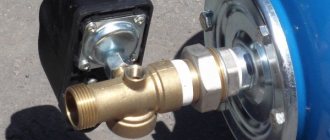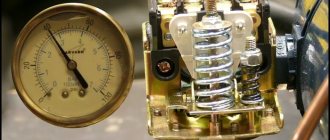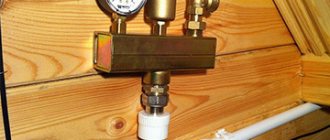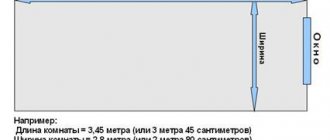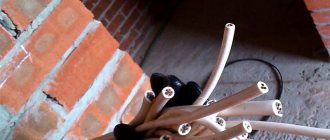Hydraulic tank functions
In the process of organizing an autonomous supply of water from shallow wells in private homes, a pumping station is most often used to lift it to the surface. It is a unit assembled from a self-priming pump, a storage tank and instruments through which the station is put into operation and pressure is controlled.
- However, the station can only be installed superficially and can extract water from a maximum depth of 8 meters (we do not take ejector units into account). In deep water intakes, a submersible pump is used, and the hydraulic accumulator for it must be selected individually.
- There may be more than one such container in the system if, for example, higher pressure needs to be ensured on the upper floor. There are situations when the station simply cannot become a replacement for a hydraulic storage tank, especially since not only cold water supply is organized in the house, but also hot water.
A diagram in which, in addition to the pumping station, there are two more hydraulic tanks Source kadetbrand.ru
- The pressure in a hydraulic accumulator integrated into a particular system will not be the same, just as the containers themselves should be different. They may be similar in appearance, have the same volume or shape, and sometimes even color (it all depends on the manufacturer), but if you place the device on a network not intended for it, this will quickly make itself felt.
Only a tank for cold water is called a hydraulic accumulator; in a hot water system it is already an expansion tank. You can still put it on heating, but not on cold water. What's the difference?
Distinctive features
Inside any hydraulic tank there is a rubber bulb (membrane). So, in tanks for cold water supply systems, the water is inside this bulb, and the air pumped inside occupies the space between it and the walls of the tank itself, as shown in the photo:
Pressure in the hydraulic accumulator of the pumping station and its internal structure Source nasosovnet.ru
- In an expansion tank, the opposite is true: air is pumped into a rubber balloon, and water is around it, in contact with the metal body. Since it is intended for hot water, the permissible pressure and temperature range will be approximately the following: 10 bar/+70 degrees.
- A tank with such indicators is universal; it can also be used with cold water. If the container is intended only for cold water, the permissible pressure will be significantly lower. You can navigate the characteristics by looking at the information label pasted by the manufacturer on the container body.
The permissible air pressure is indicated on the information plate Source sima-land.ru
- And one more important question that requires clarification to understand the topic. The tank body has a certain capacity, which is specified by the manufacturer. Many people mistakenly believe that this is the amount of water that is placed inside. However, this is not so, because part of the container, and a large part, is occupied by air. The tank can only be filled to a third with water (for a body volume of 100 liters, about 30 liters of water).
Note! More water can fit into the tank only when the pressure in the accumulator - 50 liters, or any other volume - is zero. That is, there is no air in it - and, accordingly, the device is inoperative.
On what basis is pressure set?
So, we have already understood that hydraulic tanks differ only in their purpose - for a cold network or a hot one. The volume of the housing does not matter during the settings, so the pressure in a 24-liter accumulator will be the same as in the case of a hundred-liter tank.
- More volume (the shape of the body does not matter at all) means more air. Accordingly, more water will fit. The manufacturer still maintains the balance, and the pressure in the air cavity will be the same in any container (standard is 1.5 bar).
Volume and shape do not matter Source pumpekhoob.com
- When the pump is off, the operating pressure in the network should be twice as high as when it is on. However, under no circumstances should it exceed the limit stated for this device by the manufacturer.
- If necessary, the factory settings can be changed - exactly how depends on the structure of the system. If this is a pipeline that supplies water from a well to the house, the accumulator is usually configured in accordance with the factory parameters of the pressure sensor installed on it.
A well pump connected to a hydraulic accumulator Source de.decorexpro.com
- Most often the range varies between 1.4 and 2.8 bar. The pressure in a 100 liter cold water accumulator (or any other tank by volume) is adjusted 0.2 bar lower (both indicators). This makes it possible to avoid unnecessary pressure surges when turning on taps or plumbing fixtures that use water.
- If another tank is installed in the system - for hot water, then its settings are no longer oriented towards its relay, but towards the cold water accumulator, with a decrease of the same 0.2 bar.
- Maintaining such a gap is an important point, because with higher pressure in the hot pipeline, the float on the automatic air vent will constantly shift and let air in, which should not be allowed.
Advice! To obtain precisely specified pressure parameters, the air already in the tank should be completely vented, and only then pumped up to the required limit.
Pressure sensor with pressure gauge on the hydraulic tank Source rmnt.mirtesen.ru
See also: Catalog of house projects with a boiler room
In a system in which a hydraulic accumulator is present, a drop in pressure usually indicates either a loss of air through the inlet valve or a breakthrough of the rubber membrane. At the same time, when water begins to be consumed, the relay begins to make constant clicks, and the pump constantly turns on.
On a note! In a hot water supply, when the pressure drops, the emergency valve begins to leak.
Having discovered such problems, it is necessary to find out what pressure should be in the pumping station in the accumulator and compare it with the actual one. Perhaps you just need to pump up the air. If this does not help, you will have to disassemble the housing and check the integrity of the membrane.
How to choose a hydraulic accumulator for water supply systems of a private house
Before purchasing, you should consider all the parameters of the hydraulic tank
Particular attention should be paid to:
- tank volume;
- type of location;
- type of energy storage;
- nominal pressure;
- cost of the selected model.
The certificate of conformity for a hydraulic tank looks like this.
When purchasing, you should ask your sales consultant about the availability and cost of replacement membranes or cylinders for the selected model and how accessible they are in principle. It would be useful to check the accompanying documentation and certificate of conformity, as well as clarify the warranty period for the device.
Important information! If you plan to install it yourself, you need to find out whether this is a reason to void the warranty. Some manufacturers oblige buyers to hire professional installers - this is prescribed as one of the clauses of the warranty service agreement.
It is quite difficult to understand the range of such products. Today, products from various companies are presented on store shelves. In order to help the reader, we will consider the most famous and popular among the population.
Diagram of a water supply device from a well with the inclusion of a hydraulic accumulator
How to set the pressure on the relay
Questions like: “What pressure should be in a 100-liter hydraulic accumulator?” are asked by readers with enviable consistency. We have already established that the volume of the tank does not affect these parameters, so 50 liters or 24 - there is no difference. It is important to install a sensor that stabilizes the operation of the system and correctly set the upper and lower pressure limits on it.
The pressure will be controlled by a relay Source stroje.bazar.sk
So let's figure out how to set up the accumulator pressure switch. The process depends on the type of device, which can be either mechanical or electronic. In the mechanical one, which is shown in the photo above, the closure of contacts in the power circuit is provoked by compression of the spring. The electronic device is controlled by a pressure sensor, which changes the electrical resistance by compressing the piezocrystal.
Electronic pressure switch for hydraulic accumulator Source fervently.ru
Despite the fact that the network pressure control sensor may be located quite far from the pump relay, it still protects the water supply from leaks and destruction. In an electronic device, all settings are made by pressing buttons on the front panel, but in a mechanical device you have to tighten the nuts.
Some very important nuances depend on how to adjust the water pressure switch with a hydraulic accumulator. With this you can achieve:
- increasing the capacity of the tank, which increases with increasing pressure;
- extending the service life of the tank membrane by reducing the upper pressure value;
- stabilizing the water pressure in taps and other points of analysis by reducing the difference between the upper and lower pressure indicators on the relay, as shown in the picture below.
How to reduce pressure difference Source greendom74.ru
Which pumping station unit is responsible for regulating pressure?
A standard pumping station for water supply to a house or cottage (otherwise it is also called a “reckless”) consists of several main components: a pump, a hydraulic accumulator tank, a pressure gauge, a relay, and connecting elements (adapters, pipes).
In addition, it can be equipped with additional options: dry-running protection, overheating protection, and a filter.
How to regulate?
The water pressure is regulated by a special relay, which is called a “pressure switch” and is necessarily included in the kit of any pumping station. With its help, the pump is turned off when its maximum set value is reached and turned on when it drops to a certain level.
Most of the relays that modern household pumping stations are equipped with are a metal base on which two spring regulators are mounted: a large one with the designation “–P+” and a smaller one with the designation “-∆P+”. In addition to the regulators, there are terminals for connecting the pump, 220 V network and grounding, as well as a contact group.
The whole thing is covered with a plastic lid on top. A membrane is installed at the bottom of the relay base, which is closed by a flange of a connecting pipe, usually made in the form of a quick-release connection (“American”) and with the help of which it is attached to the adapter of the pumping station.
Video description
An example of setting up a pressure switch in the video:
See also: Catalog of companies that specialize in swimming pools and related equipment
Step by Step Actions
We offer instructions in pictures that will help you understand how to set up a mechanical relay:
| No. | Photo for clarity | A comment |
| 1. | Note: Relay settings must be done with the system fully assembled and put into operation. | |
| 2. | Having previously de-energized the device and unscrewed just one screw with a screwdriver, you need to remove the relay cover. | |
| 3. | The large spring, by changing the pump activation pressure, is responsible for shifting the entire operating range. A small spring, by changing the shutdown pressure, changes the operating range up or down. | |
| 4. | The factory setting of such a relay most often corresponds to 1.4/2.8 atm. Let's say you need to shift the range upward by setting it to 2/3 atm. To adjust the activation pressure, you need to tighten the nut on the large spring a couple of turns clockwise. Use a socket or open-end wrench. | |
| 5. | Before carrying out this procedure, you need to relieve the pressure in the system by unscrewing any tap and waiting for the pump to turn on. If at this moment the pressure gauge shows 2 atmospheres, then everything worked out for you. | |
| 6. | If the number on the pressure gauge display is less than necessary, you will have to tighten the nut of the large spring a little more. With a higher value, the nuts need to be loosened slightly. After each displacement of the nut, the entire procedure with releasing pressure must be repeated. | |
| 7. | The cut-in pressure is set. Now our task is to reduce the difference between it and the upper limit, since in the factory setting of the device it was 1.5 atm, but we need to make it 1 atm. To achieve this, you need to loosen the nut on the small spring. Start with one full turn. | |
| 8. | To make sure the settings are correct, perform the same manipulation of opening the tap. Only now the pressure gauge readings need to be taken not at the moment the pump is turned on, but at the moment it is turned off after the tap is closed. According to the parameter given as an example, the arrow should show 3 atmospheres. Having achieved the required pressure gauge readings, replace the relay cover and you can connect the pump to the network. |
Photo source: Youtube.com
Purpose of operation of hydraulic accumulators
Hydraulic accumulator device
To provide the house with water, submersible or surface pumps are fully used. Depending on the type of pump, the accumulator can be horizontal or vertical. How air bubbles will be removed from the water depends on the design. The choice of a suitable device will depend on the location of the pumping station and the power of the pump.
The devices differ in types and sizes, but have the same functions, namely:
- Accumulate and release hydraulic energy;
- Suppresses water hammer and pulsations;
- Contributes to the normal operation of the entire water supply system. Hydraulic accumulators are universal and for this reason are widely used in most industries. They are also used in sea, air and maritime transport.
Air in the accumulator
Due to the special design of the hydraulic accumulator tank, loads are reduced. The hydraulic tank is divided into two parts (water and air) by a membrane. The pressure in the accumulator softens the water hammer that is inevitable during plant operation. The hydraulic accumulator is also capable of maintaining pressure in the pump system.
Video description
What the pressure should be, see the video:
Optimizing underpressure
The problem of excess pressure also occurs, but quite rarely. Most often it is not enough, and this issue is solved in several ways. Here are the two most popular.
With booster pump
A booster pump is included in the system. That is, this pump is not present to supply water, but to forcibly increase its pressure. This solution can be considered optimal when there is water in the source, but due to its distance from the distribution points, it loses pressure along the way.
Scheme with booster pumps Source ppt-online.org
It is ideal when such a pump is controlled automatically, which itself starts and stops its operation when necessary. This option is suitable for both private houses and apartments, but in the latter case there is a risk of leaving neighbors without water.
Using a storage tank
If there is not enough water in the well (the flow rate of the source is reduced), installing a booster pump will not only not solve the problem, but will also aggravate it. In this case, a sufficiently large storage tank must be installed in front of this pump, and in the absence of water intake, water will be pumped into it.
In this case, the owner himself will decide what pressure is in the accumulator, because this is not important. If such a tank is equipped with a float sensor, it will itself give the pump a command to turn on when the water in the tank is used up to a certain limit.
System with large storage capacity Source seid-nn.ru
If you place the container in the attic, it will also be filled by means of a pump, but it will flow to the flow points by gravity. True, the pressure will not be strong enough, and most likely, you will have to install another pump that will supply water from the tank. By using the second pump, you can place the barrel anywhere – even in the basement.
Installing a hydraulic accumulator
After purchasing a suitable model of electric pump for a well or well and connecting it to the pipeline, calculating the volume and purchasing the required hydraulic tank, you need to install it correctly. If the model has a large volume and is installed on vertical legs, you should use the following recommendations:
- It is better to install a volumetric storage tank at the highest point of the house (attic, second floor) - this will create maximum pressure in the water line.
- The floor in the room must be level, humidity must not exceed established standards in order to avoid corrosion of the galvanized flange and surface of the tank.
- It is better to connect the device using a flexible pressure hose in a stainless steel braid and one-inch diameter union nuts made of brass. You should avoid supply hoses with aluminum braiding and mounting couplings made of cheap silumin, a brittle aluminum-silicon alloy.
Rice. 10 Connection diagram for a hydraulic accumulator for individual water supply systems
Purpose of hydraulic accumulators and expansion tanks
Initially, we will divide all the tanks under consideration into two main types. The first type is devices designed to compensate for excess pressure (volume) in heating devices. These are expansion tanks, or “expansion tanks” from the English word “expansion” - expansion. To imagine why expansion machines are needed, consider the operation of the heating system. When the boiler heats up, the temperature of the coolant fluid in it rises. When heated, the liquid expands. This leads to an increase in its volume by approximately 0.3% for every 10°C. Therefore, with an increase in temperature by 70°C, the initial volume of coolant will increase by approximately 3%. The liquid is practically incompressible and if the heating system is not equipped with an additional device that allows this volume to escape somewhere, its destruction will inevitably occur. To eliminate this, expansion (compensation) tanks are used. Open expansion tanks, common in the past, had a number of disadvantages and are now practically not used. Taking into account Russian engineering conservatism, we will once again describe some of the disadvantages of open expansion tanks:
- The presence of an open tank determines the increased volatility of the liquid and the need for constant replenishment;
- More expensive installation of an open tank. It must be installed at the very top of the heating system. It is necessary to provide a special place and ensure that it is insulated and prevents freezing, while a closed tank can be installed anywhere;
- Increased corrosion in the system due to access to oxygen;
- An open heating system operates at low pressure and is therefore difficult to control.
The second main type of tank is water tank (hydraulic accumulator). Their task is to accumulate a certain amount of water and release this amount under the right pressure at the right time. Like heating systems, water tanks can be open or closed. All the disadvantages listed earlier for open tanks of heating systems also apply to water tanks. But in addition, a device is needed to prevent the tank from overfilling. The appearance of expansion machines and hydraulic accumulators is shown in the figures below
Prevention, repair and troubleshooting
Any types of hydraulic accumulators for water supply systems require comprehensive maintenance and timely prevention.
There are a huge number of reasons for the breakdown of expansion tanks, but the main ones are the high frequency of pumping equipment switching on, water supply through a check valve, low water pressure, low operating pressure in the hydraulic tank, damage to the internal membrane or outer walls of the housing, and incorrectly selected tank volume.
In order to eliminate serious breakdowns and prevent the emergency condition of the tank, regular inspections and preventative maintenance of the device are required.
Some breakdowns can be resolved as follows:
- Air pressure is increased by forcing it through the nipple hole using pumping or compressor equipment.
- The damaged surface of the membrane or housing is restored in the service center (service center). If there is serious damage, they are replaced.
- The pressure difference is equalized by significantly increasing the differential, taking into account the operating frequency of the installed pumping equipment.
- The sufficient volume of the hydraulic tank is determined before installation work begins.
To ensure uninterrupted operation of the system, there should be no air pockets in it. The frequency of inspections is once every 3 months. During this period, full control is carried out over the set pump response thresholds, relay settings, the tightness of the housing, the serviceability of the membrane and the absence of leaks.
Incorrect adjustment of any element of the system can affect the performance and durability of the hydraulic tank.
The hydraulic accumulator for hot water and cold water supply is successfully used in private households. Proper connection and configuration of the device will ensure a long service life and efficient operation of the water supply system.


